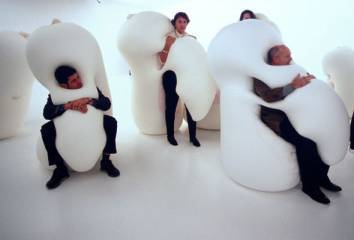Ernesto Neto
18 Feb - 01 May 2006
Ernesto Neto
THE MALMÖ EXPERIENCE
18.2 – 1.5 2006
Ernesto Neto works with abstract installations which often take up the entire exhibition space. His materials are gossamer-thin, light, stretchable fabrics in nylon or cotton. Like fine membranes fixed to the ceiling by long, stretched threads his works hang down into the room and create shapes that are almost organic. Sometimes they are filled with scented spices and hang in tear-shaped forms like gigantic mushrooms or huge stockings, sometimes he creates peculiar soft sculptures which the visitor is allowed to feel through small openings in the surface. He also creates spatial labyrinths which the visitor can enter and thereby experience the work and interact with it.
Neto’s art is a sensual experience which creates associations with the body and with something organic. He describes his works as an exploration and a representation of the body’s landscape from within. It is important to Neto that the viewer should actively interact with and physically experience his work by feeling, smelling, and touching it.
For Malmö Konsthall Neto will create a completely new work which he is calling The Malmö Experience. The exhibition in Malmö will provide an extensive overview and synopsis of Neto’s oeuvre and contain a number of important works which will be presented in a new way. In a huge “organic labyrinth” of fabrics and shapes, which takes up the entire exhibition space, the visitor can experience the work from both inside and outside. The exhibition is based on the colours of the rainbow and the body labyrinth/organism consists of a number of smaller spaces which together constitute the whole.
Ernesto Neto is considered one of the absolute leaders of Brazil’s contemporary art scene. His inspiration comes partly from Brazilian neo-concretism. At the end of the 1950s and beginning of the 60s the movement’s best-known proponents, Lygia Clarc and Hélio Oiticica, rejected modernism’s ideas of autonomous geometric abstraction. Instead, they wanted to equate art with living organisms in a kind of organic architecture, and invite the viewer to be an active participant.
Ernesto Neto was born in 1964 in Rio de Janeiro, Brazil, where he lives and works.
He has had a long series of exhibitions around the world, including the Freud Museum, Vienna 2005; Domain de Kerguéhennec, Centre d’art contemporain, France, 2005; Centro Cultural São Paolo, 2004; the Hirschhorn Museum and Sculpture Garden, Washington DC, Kunsthalle Basel, 2003; Århus Kunstbygning, 2002; the Brazilian pavilion at the Venice Biennale, 2002; the XXIV Bienal International de São Paolo, 1998 and the Sydney Biennial, 1998.
www.konsthall.malmo.se
© Ernesto Neto, Humanoids, 2001
Kolnischer Kunstverein, Cologne, 2001
THE MALMÖ EXPERIENCE
18.2 – 1.5 2006
Ernesto Neto works with abstract installations which often take up the entire exhibition space. His materials are gossamer-thin, light, stretchable fabrics in nylon or cotton. Like fine membranes fixed to the ceiling by long, stretched threads his works hang down into the room and create shapes that are almost organic. Sometimes they are filled with scented spices and hang in tear-shaped forms like gigantic mushrooms or huge stockings, sometimes he creates peculiar soft sculptures which the visitor is allowed to feel through small openings in the surface. He also creates spatial labyrinths which the visitor can enter and thereby experience the work and interact with it.
Neto’s art is a sensual experience which creates associations with the body and with something organic. He describes his works as an exploration and a representation of the body’s landscape from within. It is important to Neto that the viewer should actively interact with and physically experience his work by feeling, smelling, and touching it.
For Malmö Konsthall Neto will create a completely new work which he is calling The Malmö Experience. The exhibition in Malmö will provide an extensive overview and synopsis of Neto’s oeuvre and contain a number of important works which will be presented in a new way. In a huge “organic labyrinth” of fabrics and shapes, which takes up the entire exhibition space, the visitor can experience the work from both inside and outside. The exhibition is based on the colours of the rainbow and the body labyrinth/organism consists of a number of smaller spaces which together constitute the whole.
Ernesto Neto is considered one of the absolute leaders of Brazil’s contemporary art scene. His inspiration comes partly from Brazilian neo-concretism. At the end of the 1950s and beginning of the 60s the movement’s best-known proponents, Lygia Clarc and Hélio Oiticica, rejected modernism’s ideas of autonomous geometric abstraction. Instead, they wanted to equate art with living organisms in a kind of organic architecture, and invite the viewer to be an active participant.
Ernesto Neto was born in 1964 in Rio de Janeiro, Brazil, where he lives and works.
He has had a long series of exhibitions around the world, including the Freud Museum, Vienna 2005; Domain de Kerguéhennec, Centre d’art contemporain, France, 2005; Centro Cultural São Paolo, 2004; the Hirschhorn Museum and Sculpture Garden, Washington DC, Kunsthalle Basel, 2003; Århus Kunstbygning, 2002; the Brazilian pavilion at the Venice Biennale, 2002; the XXIV Bienal International de São Paolo, 1998 and the Sydney Biennial, 1998.
www.konsthall.malmo.se
© Ernesto Neto, Humanoids, 2001
Kolnischer Kunstverein, Cologne, 2001

